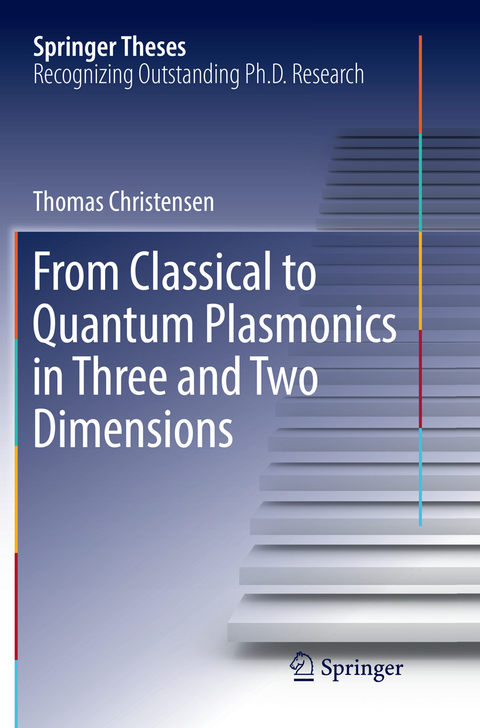
From Classical to Quantum Plasmonics in Three and Two Dimensions
Seiten
2018
|
1. Softcover reprint of the original 1st ed. 2017
Springer International Publishing (Verlag)
978-3-319-83973-8 (ISBN)
Springer International Publishing (Verlag)
978-3-319-83973-8 (ISBN)
This thesis provides a comprehensive introduction to two active research directions within the field of plasmonics: (i) nonclassical, or quantum, aspects of the plasmonic response; and (ii) two-dimensional plasmonics, a recent innovation in the field stimulated by the advent of two-dimensional materials. It discusses the fundamentals of this field in detail, and explores several current research directions.
Nonclassical plasmonics has been spurred on in recent years by the tremendous technological progress in nanofabrication and optical characterization; today, it is possible to investigate the plasmonic features of nanostructures with characteristic features in the few nanometer range. The book describes and analyzes the breakdown of the classical theory under these conditions and explores several alternatives and extensions. The unique electronic and dimensional features of novel two-dimensional materials, such as graphene, lie at the coreof plasmonics' most rapidly developing subfield; two-dimensional plasmonics. This thesis provides a clear and comprehensive exposition of the central features for interested researchers looking for an entry point to this riveting area.
Nonclassical plasmonics has been spurred on in recent years by the tremendous technological progress in nanofabrication and optical characterization; today, it is possible to investigate the plasmonic features of nanostructures with characteristic features in the few nanometer range. The book describes and analyzes the breakdown of the classical theory under these conditions and explores several alternatives and extensions. The unique electronic and dimensional features of novel two-dimensional materials, such as graphene, lie at the coreof plasmonics' most rapidly developing subfield; two-dimensional plasmonics. This thesis provides a clear and comprehensive exposition of the central features for interested researchers looking for an entry point to this riveting area.
Introduction.- Fundamentals of Plasmonics.- Nonclassical Plasmonics.- Electronic Properties of Graphene.- Classical Graphene Plasmonics.- Nonclassical Graphene Plasmonics.- Outlook and Conclusions.
"The thesis consists of two parts, six chapters and five appendices. ... The contents of the thesis will be interesting for researches in several branches of modern physics, for university lecturers and postgraduate students." (Yulianna Perepelkina, zbMATH, Vol. 1366.82002, 2017)
| Erscheinungsdatum | 05.03.2022 |
|---|---|
| Reihe/Serie | Springer Theses |
| Zusatzinfo | XX, 181 p. 39 illus., 14 illus. in color. |
| Verlagsort | Cham |
| Sprache | englisch |
| Maße | 155 x 235 mm |
| Gewicht | 320 g |
| Themenwelt | Naturwissenschaften ► Physik / Astronomie ► Allgemeines / Lexika |
| Schlagworte | Electron Energy Loss Spectroscopy in Plasmonics • Graphene Plasmonics • Hydrodynamic Model in Plasmonics • Multipolar Plasmons • Nonlinear Plasmonics in Graphene • Nonlocality in Plasmonics • Quantum Nanoplasmonics • Two-Dimensional Plasmonics |
| ISBN-10 | 3-319-83973-X / 331983973X |
| ISBN-13 | 978-3-319-83973-8 / 9783319839738 |
| Zustand | Neuware |
| Haben Sie eine Frage zum Produkt? |
Mehr entdecken
aus dem Bereich
aus dem Bereich
Band 1: Mechanik und Thermodynamik
Buch | Softcover (2022)
Wiley-VCH (Verlag)
39,90 €
für Studierende der Naturwissenschaften und Technik
Buch | Hardcover (2024)
Springer Spektrum (Verlag)
79,99 €


